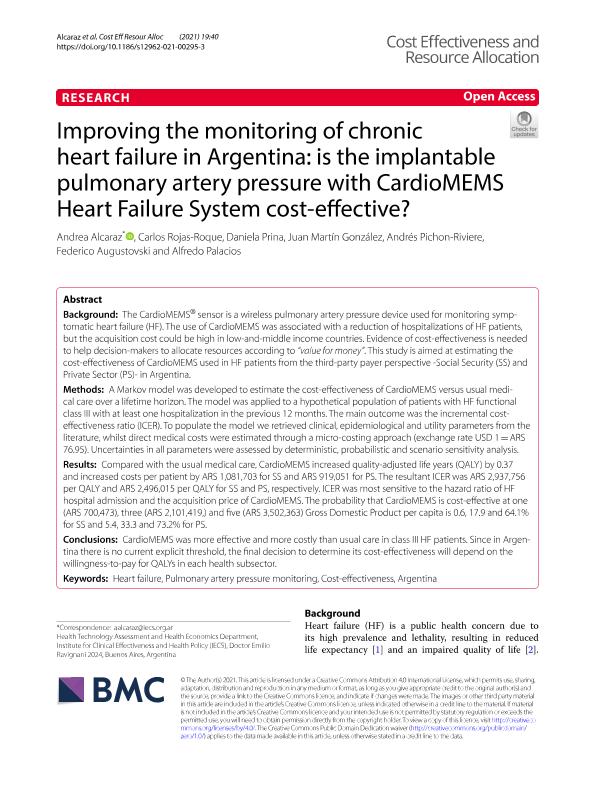Artículo
Improving the monitoring of chronic heart failure in Argentina: is the implantable pulmonary artery pressure with CardioMEMS Heart Failure System cost-effective?
Alcaraz, Andrea; Rojas Roque, Carlos; Prina, Daniela Luciana; González, Juan Martín; Pichón-riviere, Andres ; Augustovski, Federico Ariel
; Augustovski, Federico Ariel ; Palacios, Alfredo
; Palacios, Alfredo
 ; Augustovski, Federico Ariel
; Augustovski, Federico Ariel ; Palacios, Alfredo
; Palacios, Alfredo
Fecha de publicación:
12/2021
Editorial:
BioMed Central
Revista:
Cost Effectiveness and Resource Allocation
ISSN:
1478-7547
Idioma:
Inglés
Tipo de recurso:
Artículo publicado
Clasificación temática:
Resumen
Background: The CardioMEMS® sensor is a wireless pulmonary artery pressure device used for monitoring symptomatic heart failure (HF). The use of CardioMEMS was associated with a reduction of hospitalizations of HF patients, but the acquisition cost could be high in low-and-middle income countries. Evidence of cost-effectiveness is needed to help decision-makers to allocate resources according to “value for money”. This study is aimed at estimating the cost-effectiveness of CardioMEMS used in HF patients from the third-party payer perspective -Social Security (SS) and Private Sector (PS)- in Argentina. Methods: A Markov model was developed to estimate the cost-effectiveness of CardioMEMS versus usual medical care over a lifetime horizon. The model was applied to a hypothetical population of patients with HF functional class III with at least one hospitalization in the previous 12 months. The main outcome was the incremental cost-effectiveness ratio (ICER). To populate the model we retrieved clinical, epidemiological and utility parameters from the literature, whilst direct medical costs were estimated through a micro-costing approach (exchange rate USD 1 = ARS 76.95). Uncertainties in all parameters were assessed by deterministic, probabilistic and scenario sensitivity analysis. Results: Compared with the usual medical care, CardioMEMS increased quality-adjusted life years (QALY) by 0.37 and increased costs per patient by ARS 1,081,703 for SS and ARS 919,051 for PS. The resultant ICER was ARS 2,937,756 per QALY and ARS 2,496,015 per QALY for SS and PS, respectively. ICER was most sensitive to the hazard ratio of HF hospital admission and the acquisition price of CardioMEMS. The probability that CardioMEMS is cost-effective at one (ARS 700,473), three (ARS 2,101,419,) and five (ARS 3,502,363) Gross Domestic Product per capita is 0.6, 17.9 and 64.1% for SS and 5.4, 33.3 and 73.2% for PS. Conclusions: CardioMEMS was more effective and more costly than usual care in class III HF patients. Since in Argentina there is no current explicit threshold, the final decision to determine its cost-effectiveness will depend on the willingness-to-pay for QALYs in each health subsector.
Archivos asociados
Licencia
Identificadores
Colecciones
Articulos(CIESP)
Articulos de CENTRO DE INVESTIGACIONES EN EPIDEMIOLOGIA Y SALUD PUBLICA
Articulos de CENTRO DE INVESTIGACIONES EN EPIDEMIOLOGIA Y SALUD PUBLICA
Citación
Alcaraz, Andrea; Rojas Roque, Carlos; Prina, Daniela Luciana; González, Juan Martín; Pichón-riviere, Andres; et al.; Improving the monitoring of chronic heart failure in Argentina: is the implantable pulmonary artery pressure with CardioMEMS Heart Failure System cost-effective?; BioMed Central; Cost Effectiveness and Resource Allocation; 19; 1; 12-2021; 1-11
Compartir
Altmétricas



